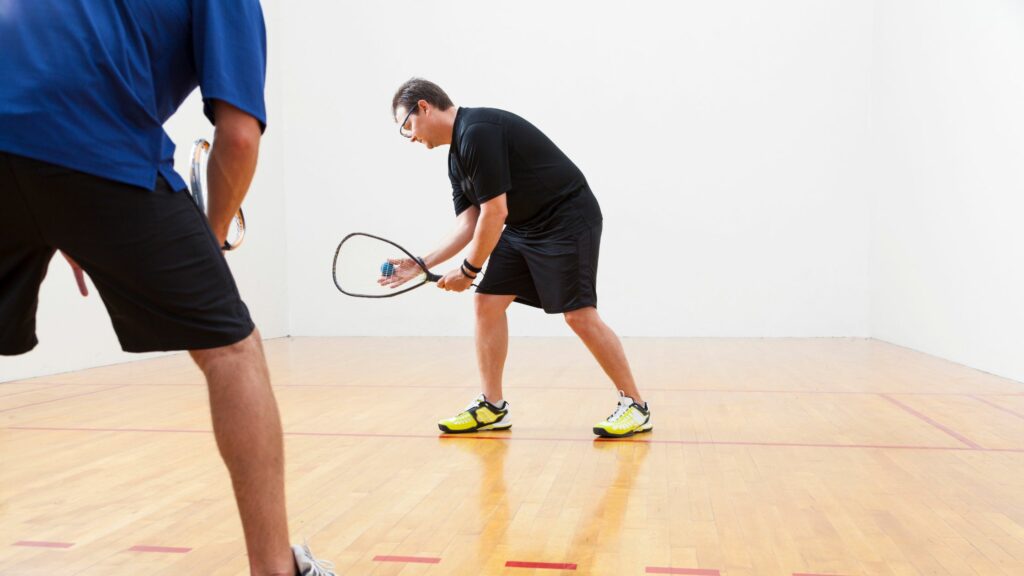This article is the second in a series on injury prevention with exercise. In this first installment, Dr. Bryce Lee, DPT, explains how to prevent overuse injuries with a conservative, gradual approach to new activities.
Ok, so you’ve read part one of this series, and you have a good sense of what types of activities cause overuse injuries. Maybe you are feeling frustrated to learn that the very sport or activity you were hoping to undertake checks all the boxes.

Perhaps your work buddies all play racquetball. From the last article you know that racquetball might put you at risk for an overuse injury because of the novel movements, high forces, and lots of reps that aren’t individually fatiguing. And, you know you’ve been pretty sedentary the past few years. The quick side-to-side cutting involved is likely to represent a drastic change in activity for you, and your body may not be used to those kinds of forces on your joints.
Take heart! You don’t have to give up on your goal of enjoying racquetball, or running, or kickboxing, or whatever other physical activity you enjoy. Instead, you need to give your body plenty of time to fully adapt with a gradual increase in activity.
To prevent overuse injuries, regress before you progress.
Now that we’ve discussed all the predisposing factors, I’d like to give you a straightforward plan for how to avoid overuse injuries with any new activity. We’ll apply the same rationale that goes into popular “couch-to-5k” programs and other strategies to adopt new physical hobbies. But I’ll translate that rational into a general framework that you can apply to any activity.
Essentially, we are going to start at the end and work backwards. The “end” is whatever event we ultimately want to be able to do. For example, play 2 sets of tennis (roughly 200-300 strokes), or run a 5k (roughly 30 minutes of running), or hike a moderate 5 mile trail. Once we have a realistic end point we then break that down into extremely small and accessible doses, so that our body can easily recover.
Rule 1: Set a realistic goal
No amount of strategizing, expert coaching, and optimized training could prepare me personally to summit Mt. Everest in 6 weeks, or even 6 months. The most important first step in adopting an activity is to set a realistic goal about that activity. Take a good look in the mirror, and ask: “Am I so genetically gifted that I could go from barely walking 3000 steps per day, to hiking Old Rag in 6 weeks?” If you’re not, choose something realistic to shoot for in the next 3 months – you can always set a new goal after you hit this one!

A good starting point is to consider the length ofyour “event,” whether it’s a 1 hour kickboxing class, or a 4 hour hike. Most programs for preparing for a major event involve a weekly training volume that is at least as long as the event length itself for a long event, and more than double the event-length for a short event. So to run a marathon, you should prepare for an average of 20-30 miles per week of running (on the low end).
A goal is unrealistic if you don’t have room in your schedule to do the training.
Now look at your own schedule, Do you have 4 to 6 additional hours per week for training? If not, a 4 hour marathon is not a realistic 2-month goal. But you might have three 30 minute training windows to prepare for a half-hour 5k race in 8 weeks. To prevent overuse injuries, start with something realistic, and build your next goal on top of your success in this one.
Rule 2: Start with 25% of your goal volume, and add 5% per week.
As a rough estimation, 25% of the goal volume is a decent starting point for most people.
Does that sound too easy? Good. Starting slower than you think you need may result in slower progress, but even slow progress beats time spent nursing an injury.
If you are young and have no health issues, you might be a little more aggressive with 30-35%. If you have diminished recovery due to age and systemic issues, you might start with only 15-20% of goal volume.
What does “volume” mean? Well:
- 25% of a 5k (30 minutes of running) would be about 7 to 8 minutes of total running during each of your first few workouts.
- 25% of a session of tennis or racquetball might be a total of 50-70 total tennis strokes during your first few practices.
- 25% of climbing Old Rag (2500 feet of elevation gain!) might be about 600 feet of elevation gain on a treadmill (2 miles at 5-6% incline).
25% of your goal volume should feel easy! If it doesn’t, reduce your training volume until it does feel easy, and take things slow. Make small increases of roughly 5% per week until you reach your goal, and you’ll likely prevent any overuse injuries from derailing your training.
This might look like a weekly increase of 2-3 total minutes of running in each workout, or an extra 20-30 strokes in each tennis practice. Go slow, so it never feels like you are pushing the limits of your recovery.
Rule 3: Start with 1 minute of work, 2 minutes rest, and slowly increase.

Now that we have an idea of how much volume (total exercise) to do in our first few workouts, we also have to dose it correctly. A safe play here is a work-to-rest ratio of 1 to 2. That means for every minute of exercise, we do two minutes of resting or walking. If you spend 1 minute hitting tennis balls, rest 2 minutes. If you spend 2 minutes swimming a lap, rest 4 minutes before starting again. You can do other things like brisk walking during your breaks to keep your heart rate elevated, but we want to avoid the overuse of too many repetitions at once for your chosen activity.
Each week, you can decrease rest as you increase your volume. If you started by running 8 minutes in a 30 minute session, you can add 2-3 minutes of running and reduce your rest by the same amount, keeping the session length constant.
By the 10th week, you might be doing 75% of your goal in volume, and working 3 minutes at a time with only 1 minute of rest Again, this is a very conservative approach to dosing your exercise. Can you rest less? Of course. But if you are interested in enjoying this new activity for years, not just the next two months, taking things very slow is how you will avoid overuse injuries and see greater improvements in the long term.
Rule 4: Train the new activity three times per week, at most.
Again, conservative. I know. If the activity is very low impact (tai chi), you probably have less to worry about. but if the activity checks two or three of the risk factors, play it safe. Even yoga, which can involve deeply stretching muscles for long periods, and holding challenging positions, can cause injuries if you don’t give your body enough time to adapt.
There is a reason that couch-to-5k programs typically involve only 3 days per week of doing running or your chosen activity. Two remaining days should be devoted to general strengthening and conditioning (like we do at StrengthSpace), and two days should be for complete rest from focused exertion.

Rule 5: When in doubt, consult a pro.
Does your activity fit neatly into the above framework? Great! But if it doesn’t, consult an expert coach in your sport. Maybe you are considering taking up kickboxing classes where you don’t really have control over how long the classes are.
In this case, don’t make the mistake of going for the most affordable group class you can find. I have treated many patients who launched themselves into step-aerobics, kickboxing, or dance-based exercise classes, only to find themselves hurting and unable to train a few weeks later.
If your plan is to enjoy years of kickboxing, dancing, or any other highly technical activity, make the investment in lessons with a genuine expert who can optimize your technique. A professional with a great reputation will know how to ease you into the activity based on your baseline levels of skill, strength, and activity, so you never get hurt in the first place. Don’t skimp on this, because if an injury does present, you’d pay ten times the cost of good instruction to make the pain go away.
Let’s Recap
Novel activities with high forces, lots of repetitions, and low fatigue levels all increase your risk for an overuse injury. Your own health status can increase your need for caution. To prevent overuse injuries in the first place, set a reasonable goal level of activity. Begin with 25% of your goal volume, and only 1 minute of bouts of effort, with 2 minutes rest in between. Train only 3 times per week. Each week, progress volume by 5%, and decrease rest intervals by 5-10%, until you are resting minimally and working at close to your event-pace by week 12. And when in doubt, consult an expert for any technically challenging activity.
Follow the simple framework for adopting a new activity, and instead of a short-lived career that ends in injury and frustration, you’ll set yourself up for a life-time of recreational enjoyment,
